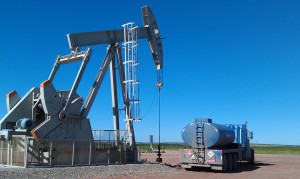By Lynn Helms – NDIC Department of Mineral Resources
- May Oil: 19,839,420 barrels = 639,277 barrels/day
- Jun Oil: 19,809,662 barrels = 660,332 barrels/day (preliminary) > NEW all-time high
- May Gas: 21,360,912 MCF = 689,062 MCF/day
- Jun Gas: 21,381,942 MCF = 712,7312 MCF/day (preliminary) > NEW all-time high
- May Producing Wells = 7,205
- Jun Producing Wells = 7,352 (preliminary) > NEW all-time high
May Permitting: 180 drilling and 2 seismic
Jun Permitting: 204 drilling and 0 seismic (all time high was 245 in Nov 2010)
May Sweet Crude Price = $79.44/barrel
Jun Sweet Crude Price = $72.58/barrel
Today Sweet Crude Price = $80.00/barrel ND (all-time high was $136.29 July 3, 2008)
- May rig count 211
- June rig count 213
- July rig count 211
Today’s rig count is 203 (all-time high was 218 on May 29, 2012)
 Comments:
Comments:
Great weather and additional crews resulted in increased hydraulic fracturing activity and increased production. Rig count has now decreased slightly to around 200-205 and rig efficiency continues to improve with the spud to TD time now averaging 20 days. Daily production increased 3.3% from May to June. Over 95% of drilling still targets the Bakken and Three Forks formations. The idle well count stayed about the same indicating an estimated 347 wells waiting on fracturing services. This is expected to lead to significant production increases through the summer as additional fracturing crews are added.
Crude oil take away via pipeline is now less than 50% of daily production, but rail and truck transportation are adequate to keep up with near term production projections. The North Dakota Sweet posted price basis is now -14% to NYMEX-WTI and NYMEX-WTI basis is now -18% to Brent. This is resulting in an increasing amount of North Dakota crude oil transported on rail so it can reach destinations that pay Brent price.
Rig count in the Williston basin is decreasing slightly. Utilization rate for rigs capable of +20,000 feet remains over 95%. Many of the new built rigs are scheduled to replace older less efficient ones. For shallow well rigs that drill to 7,000 feet or less utilization remains about 50%.
Drilling permit activity has increased as more multi-well pads are being drilled and locations need to be built before winter weather comes.
The number of rigs actively drilling on federal surface in the Dakota Prairie Grasslands is steady at 3.
The number of wells drilling on the Fort Berthold Reservation has dropped to 30 with 5 on fee lands and 25 on trust lands.
There are now 680 wells producing (95 on trust lands & 585 on fee lands) 109,500 barrels of oil per day (7,700 from trust lands & 101,800 from fee lands) within the boundaries of Fort Berthold
109 wells waiting on completion
231 approved drilling permits (216 on trust lands & 15 on fee lands)
1,350 additional potential future wells (1,185 on trust lands & 165 on fee lands)
Seismic is very busy with 4 surveys active/recording, 2 remediating, 0 suspended, and 10 permitted.
North Dakota leasing activity is mostly renewals and top leases in the Bakken – Three Forks area.
Daily natural gas production is increasing at the same rate slightly faster than oil production. This indicates that gas oil ratios may be increasing and more gathering and processing capacity will be needed. Construction of processing plants and gathering systems is in full swing due to the dry summer weather. US natural gas storage has dropped to 13.5% above the five-year average but still indicates low prices for the foreseeable future. North Dakota shallow gas exploration is not economic at near term gas prices.
Natural gas delivered to Northern Border at Watford City is up to $2.33/MCF. This results in a current oil to gas price ratio of 34 to 1, but the high liquids content makes gathering and processing of Bakken gas economic. Additions to the processing capacity are helping, but the percentage of gas flared was up slightly to 32%. The historical high was 36% in September 2011.
Draft BLM regulations for hydraulic fracturing on federal lands were published in the Federal Register. The comment period has been extended to 5pm EDT on September 10, 2012. All of our readers are urged to submit comments to the BLM as follows: http://www.regulations.gov/#!submitComment;D=BLM-2012-0001-0001
Mail: U.S. Department of the Interior, Director (630), Bureau of Land Management, Mail Stop 2134 LM, 1849 C St. NW., Washington, DC 20240, Attention: 1004-AE26.
Fax: Office of Management and Budget (OMB), Office of Information and Regulatory Affairs, Desk Officer for the Department of the Interior, fax 202-395- 5806.
There are a significant number of concerns with the rule as proposed, but the major points that should be commented on are as follows:
1) This is a state’s rights issue. States that have adopted hydraulic fracturing rules that include chemical disclosure, well construction, and well bore pressure testing should be exempted from the rule.
2) The EPA study of potential hydraulic fracturing effects on ground water is not finished and there are currently no known environmental contamination incidents.
3) As Chairman Hall has testified, the required consultation with the Three Affiliated Tribes has not occurred.
Draft EPA Guidance for permitting hydraulic fracturing using diesel fuel has been published. The comment period has been extended to 5pm EDT on August 23, 2012. I urge all of our readers to submit comments to the EPA as follows:
Submit your comments, identified by Docket ID No. EPA-HQ-OW-2011-1013 by one of the following methods: www.regulations.gov: Follow the on-line instructions for submitting comments. Email:OWDocket@epa.gov@epa.gov
Mail: Permitting Guidance for Oil and Gas Hydraulic Fracturing Activities Using Diesel Fuels—Draft, Environmental Protection Agency, Mailcode: 4606M, 1200 Pennsylvania Ave. NW, Washington, DC 20460.
There are a significant number of concerns with the guidance as proposed, but the major points that should be commented on are as follows:
1) This is a state’s rights issue. States that have adopted hydraulic fracturing rules that include chemical disclosure, well construction, and well bore pressure testing should be explicitly exempted from the guidance.
2) The definition of diesel fuel is too broad because it includes six CASRNs as well as any materials referred to by one of these primary names or any associated common synonyms.
3) EPA made no attempt to identify dangerous concentrations of these materials.
Hydraulic fracturing treatments that utilize concentrations of less than 10% of any material defined as diesel fuel should be exempt from permitting requirements.
4) The guidance is written for Enhanced Oil Recovery wells or disposal wells completed with tubing and packer. It shows a serious lack of understanding of the horizontal drilling-hydraulic fracturing process. Most of the requirements will not work mechanically on wells completed with swell packers and fractured down the production casing.
“Director’s Cut.” By Lynn Helms – NDIC Department of Mineral Resources (2012-8-15). Retrieved 9-5-2012.











